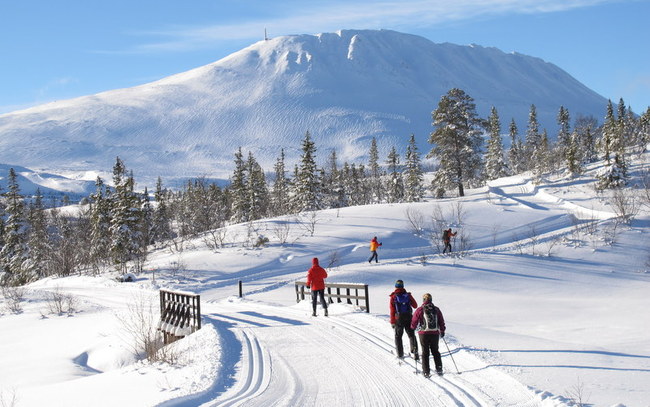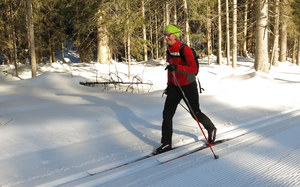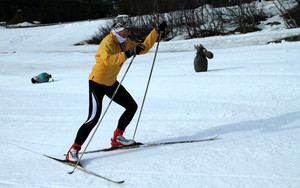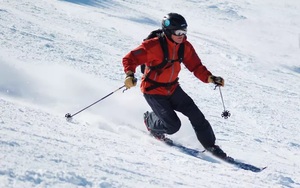All about cross country skiing
 Cross country skiing Kvitavatn, Norway [M Wray]
Cross country skiing Kvitavatn, Norway [M Wray]
What is cross country skiing
 Classic cross country skiing [Photo M Wray]Cross country skiing is an all over exercise on lightweight skis where you coordinate gliding and pushing with your legs and using poles for extra propulsion. You ski up and down hills on groomed trails - in its simplest form it's like walking with poles on skis. Add in some tuition to learn the basic techniques and you can enjoy the magic feeling of gliding and through quiet, snowy landscapes.
Classic cross country skiing [Photo M Wray]Cross country skiing is an all over exercise on lightweight skis where you coordinate gliding and pushing with your legs and using poles for extra propulsion. You ski up and down hills on groomed trails - in its simplest form it's like walking with poles on skis. Add in some tuition to learn the basic techniques and you can enjoy the magic feeling of gliding and through quiet, snowy landscapes.
And if you like a challenge there are cross country ski marathons and a host of other shorter and longer races that tempt you to travel all over the world.
It's come a long way from its origins in Scandinavia where it a necessity for life in snow-covered countryside.
Which technique - classic or skating technique?
 Skate skiingClassic is the traditional skiing technique and is generally the one beginners learn first because it's similar to walking.
Skate skiingClassic is the traditional skiing technique and is generally the one beginners learn first because it's similar to walking. - You glide then press your ski down into the snow to push yourself along and at the same time plant and press down on your pole.
- The skis run in parallel ‘grooves’ made by track grooming machines.
- You learn different techniques to get up steeper hills and how to control your speed downhill by snowploughing where necessary.
- Skating is similar to ice skating or inline skating and requires more balance and energy than classic technique but you can ski faster.
- In the Alps almost all resorts have skating tracks.
- It's growing in popularity and most resorts have skating tracks but they may be less extensive than classic tracks - check what's available if you want to skate.
How is cross country skiing different to alpine skiing?
- Your lightweight boots are only attached to the binding at the toe, so your heel is free.
- Your skis are considerably lighter and thinner than downhill skis.
- Your poles are longer than those used for Alpine skiing.
- You ski downhill on gentler slopes and you ski uphill as well as across flat terrain. It's all down to you, there are no lifts involved so you don't have to buy expensive lift passes but you might have to pay a very modest sum for a loipe [trail] pass.
Cross country skiing equipment is nothing like Alpine equipment!
Cross country skis for track skiing are light and thin. Those for classic skiing are either waxable and have an area for grip wax, or non-wax with a fishscale pattern or a synthetic textile strip[s] in the centre of the ski. When you press either type of ski down they 'grip' the snow, giving you a platform to push off from and propel yourself forwards.
Skating skis are shorter and stiffer than classic skis and you apply a glide wax down the whole ski to allow you to ski in a gliding, skating motion.
Boots for either technique are light and warm - they feel more like trainers with stiff sole. You can buy 'combi' all purpose boots, or specific classic or skating boots, the latter are higher and give more ankle support.
If you want to buy kit in the UK check out equipment suppliers on our links page. Bear in mind the cost of flying with your own skis, if you're fairly to new to the sport you'll probably find it's easier and more cost effective to hire skis in your resort. If you want to fly with skis check the airline's baggage costs and rules carefully.
Choosing clothing, accessories and boots for cross country skiing
Read the articles from our quarterly newsletter written in our Editor's inimitable style on these topics:
Biathlon
Governed by the British Biathlon Union, the Olympic sport of biathlon combines skate skiing and shooting. You might like to read 10 things to know about biathlon and Nick Jubert's article 'A novice biathlete' [opens in a Word document].
It's a difficult to sport to pursue in England although the BBU periodically organises sessions for younger people.
In Scotland courses are organised at Glenmore Lodge Outdoor Centre.
Telemarking - cross country or alpine skiing?
 Telemark skiing [Photo: https://www.telemark-pyrenees.com/]The telemark turn is a graceful technique developed by Sondre Norheim for descending steep slopes on nordic equipment. It gave birth to the modern alpine techniques in the 1930’s.
Telemark skiing [Photo: https://www.telemark-pyrenees.com/]The telemark turn is a graceful technique developed by Sondre Norheim for descending steep slopes on nordic equipment. It gave birth to the modern alpine techniques in the 1930’s.
The skier completes the turn with each ski equally weighted but with the heel of the trailing ski lifted. The technique is especially suited to soft powder. The boots are only fixed to the ski at the toe and flex like cross country boots, allowing the heel to rise and the technique to be performed. Telemark skis and boots are similar in weight to alpine kit.
According to the International Ski Federation [FIS], telemarking is an alpine discipline but in Snowsport England's view it's a cross country discipline. Does it matter? Yes, if you want to compete in the sport and need to know who sets the rules.
Off track cross country skiing
It's also possible to ski off track in Scandinavia with light nordic touring skis either on a day tour or multi-day tour - find out more about off track skiing here.
